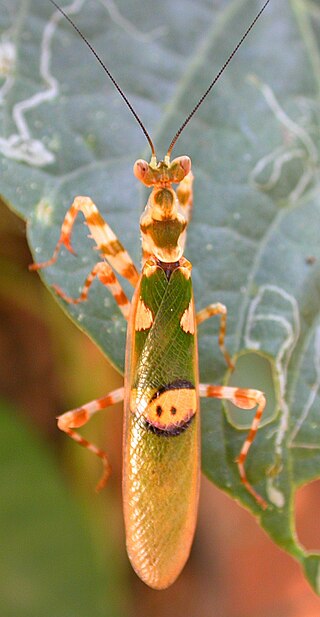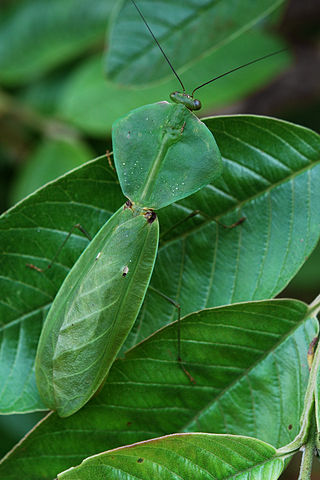
The Chinese mantis is a species of mantis native to Asia and the nearby islands. In 1896, this species was accidentally introduced by a nursery tender at Mt. Airy near Philadelphia, United States. Tenodera sinensis often is erroneously referred to as Tenodera aridifolia sinensis because it was at first described as a subspecies of Tenodera aridifolia, but Tenodera sinensis is now established as a full species.

Creobroter is a genus of flower mantises in the tribe Hymenopodini; species are concentrated in Asia. The name comes from the Greek kreo-, meaning "flesh") and broter" meaning "eating", therefore, "flesh-eating", an apt name for a predatory insect. Both sexes have long wings and are capable fliers. Full-grown males are about 3 to 4 cm in length; females are about 4 to 5 cm.

Flower mantises are praying mantises that use a special form of camouflage referred to as aggressive mimicry, which they not only use to attract prey, but avoid predators as well. These insects have specific colorations and behaviors that mimic flowers in their surrounding habitats.

Choeradodis is a genus of praying mantises with common names such as shield mantis, hood mantis, and leaf mantis because of their extended, leaf-like thoraces. The distinguishing characteristic of Choreododis from which it takes its common names is a laterally expanded thorax. This adaptation for the purpose of camouflage, as well as a rounded wing case and a habit of staying relatively flattened, aid its leaf mimicry. Tiny liverworts, lichens and fungi have been found growing on the pronotum and wing case of many Choeradodis mantids; these appear to be opportunistic growths rather than an example of coevolution with the mantids to afford extra camouflage.

Phyllocrania paradoxa, common name ghost mantis, is a small species of mantis from Africa remarkable for its leaf-like body. It is one of the three species in the genus Phyllocrania. It is known for its distinct and exclusive camouflaged appearance of a dry weathered leaf.

Tenodera angustipennis is a species of mantis native to Asia and nearby areas of Oceania. The species was introduced and became established in the eastern United States. Tenodera angustipennis was noticed as early as 1921 in Aberdeen, Maryland, but that occurrence was not noted in a published record until 1933.

Dead leaf mantis is a common name given to various species of praying mantis that mimic dead leaves. It is most often used in reference to species within genus Deroplatys because of their popularity as exotic pets. Examples include D. desiccata, D. lobata, and D. philippinica. Other species to which the term may apply include Acanthops falcataria, A. falcata, and Phyllocrania paradoxa.

Metallyticus splendidus is a rare species of praying mantis found in Southeast Asia. It has an iridescent appearance.

African mantis and African praying mantis are common names for many species of praying mantis native to Africa.

Sphodromantis gastrica, with the common names African mantis or common green mantis, is a species of praying mantis from Africa.
Pseudovates peruviana, common name Peruvian stick mantis, is a medium-sized species of praying mantis endemic to Peru.

Choeradodis stalii is a species of praying mantis with common names that include tropical shield mantis, hooded mantis, and leaf mantis. It is found in Brazil, Ecuador, French Guiana, Panama, and Peru.
Boxer mantis is a common name given to various species of praying mantis. The name comes from the way these mantises move their oversized grasping forelimbs as they communicate with each other.

Acanthops is a genus of mantises in the family Acanthopidae, containing 20 species that can be found in Central and South America.
Acanthops royi is a species of praying mantis in the family Acanthopidae and is one of many mantis from various genera that resembles a dead leaf.

Deroplatys truncata is a species of praying mantis in the family Deroplatyidae.

Acanthopidae is a family of South American mantises consisting of 16 genera in the order Mantodea. The group was first formally split off as a separate family by the German entomologist Reinhard Ehrmann in 2002. In 2016, five genera were moved from Acanthopidae to the newly created family Acontistidae, but this has not been accepted in most recent classifications.
Acanthops falcata, common name South American dead leaf mantis or boxer mantis, is a species of praying mantis in the subfamily Acanthopinae of the family Acanthopidae and is one of many praying mantises from various genera that resembles a dead leaf.

Mantises are an order (Mantodea) of insects that contains over 2,400 species in about 460 genera in 33 families. The largest family is the Mantidae ("mantids"). Mantises are distributed worldwide in temperate and tropical habitats. They have triangular heads with bulging eyes supported on flexible necks. Their elongated bodies may or may not have wings, but all Mantodea have forelegs that are greatly enlarged and adapted for catching and gripping prey; their upright posture, while remaining stationary with forearms folded, has led to the common name praying mantis.
















